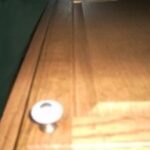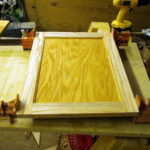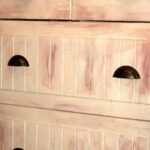Building a tambour door might sound like a difficult process. However, just the opposite is true. It is a relatively easy, step-by-step procedure that anyone can accomplish.
Tambour doors have many applications. They are often associated with roll-top desks, but a “roll-top” kitchen storage cabinet – called an appliance garage – is frequently added to renovation projects.
The tambour door is also the ideal solution for large cabinets that hold stereo equipment or for a home bar. It’s particularly suited to a cabinet built to contain a television because, once opened, the door is hidden and doesn’t block the view as a traditional swing door would. When you are finished watching television, you can pull the door down and hide the contents of the cabinet.
A tambour is made of thin, narrow strips of wood glued to a flexible backing. I have been using denim for the backing over the last few years and I’ve found that it holds up very well.
Slat width and thickness are variable, but if you have an application for a small door with a tight turning-radius, keep the slats as narrow as possible. Large applications can have wider slats because the depth of the cabinet provides plenty of room for a gently curved track.
There are a number of ways to build the door track. First I will be illustrating a router method using a straight bit and a template to cut a track into the cabinet side. But for cabinets with face frames that extend into the interior, a track can also be built behind the face frame. I will demonstrate both options in this article.
Building the Door
I will be making a tambour door For an opening 12 inches wide and 16 inches high. The tambour will be 13 inches wide by 18 inches high to fit into 112-inch-deep tracks routed into the cabinet sides.
Step 1 – Cut a piece of denim 14 inches wide by 20 inches long. Mark the denim and cut it as square as possible.
Step 2 – The denim is stretched and stapled to a board. The support board must be cut square because it will be used as a reference to align and trim the slats to length. Cut the board a little larger than the material. Pull the denim tight when stapling, but try not to stretch it beyond its normal length.
Step 3 – For this demonstration, I’m using 5/16-inch-thick by 3/4-inch-wide by 14-inch-long pine slats. Cut enough slats to cover the 18 inch finished height. In this case, I will need about 24 of them.
Step 4 – Apply contact cement to the stretched denim and to the backs of all the slats.
Step 5 – Once the contact cement is set, place the strips on the denim. It is important that the first slat is aligned at 90 degrees to the edge of the support board. Use a carpenter’s square, and carefully attach the first slat.
Step 6 – Place the remaining slats on the denim. Use the first slat as a guide and install the remainder tightly against each other as you progress up the door.
Step 7 – The dry, or cure, time for contact cement varies from 10 minutes to half an hour, but I have found that it takes much longer to dry when used on cloth. The best way I’ve found to achieve a tight bond between the slats and the material, and not
have the material buckle as it dries, is to apply weights to the support board. Turn the board over on a flat surface and place a few heavy objects evenly on the board. After drying overnight, the door will be flat and should be fully dried.
Step 8 – After drying overnight, trim the tambour to its finished size on a table saw. Use the support hoard as a guide and cut through the door and the board.
Step 9 – There are different handle options for tambour doors, including attaching a handle to the bottom slat. However, I prefer making the bottom stronger, so I often attach a 1×2 to the bottom slat, and use this as a handle. Round over all the edges and cut the 1×2 118 inch shorter than the finished opening on your cabinet.
Step 10 – The track can be routed into each side of the cabinet. The distance from the bottom of one track to the bottom of the opposite track should be 1/8 inch greater than the tambour width. That provides a small amount of play in which the door can operate smoothly.
Cut a template and use a router with a straight bit and guide bushing to cut the grooves in each cabinet side. Run them parallel to the front edge of the cabinet until you reach the top rail. Start a gentle curve back into the cabinet. The width of the track should be slightly larger than the combined thickness of the denim and the slats.
Step 11 – If your cabinet has a face frame and it is inside the cabinet opening, build a track behind the face frame. The same curve and track-thickness guidelines apply.
Building a tambour door is relatively easy. There are dozens of design options for the slats, so you should be able to make this door to suit any project you are building.





